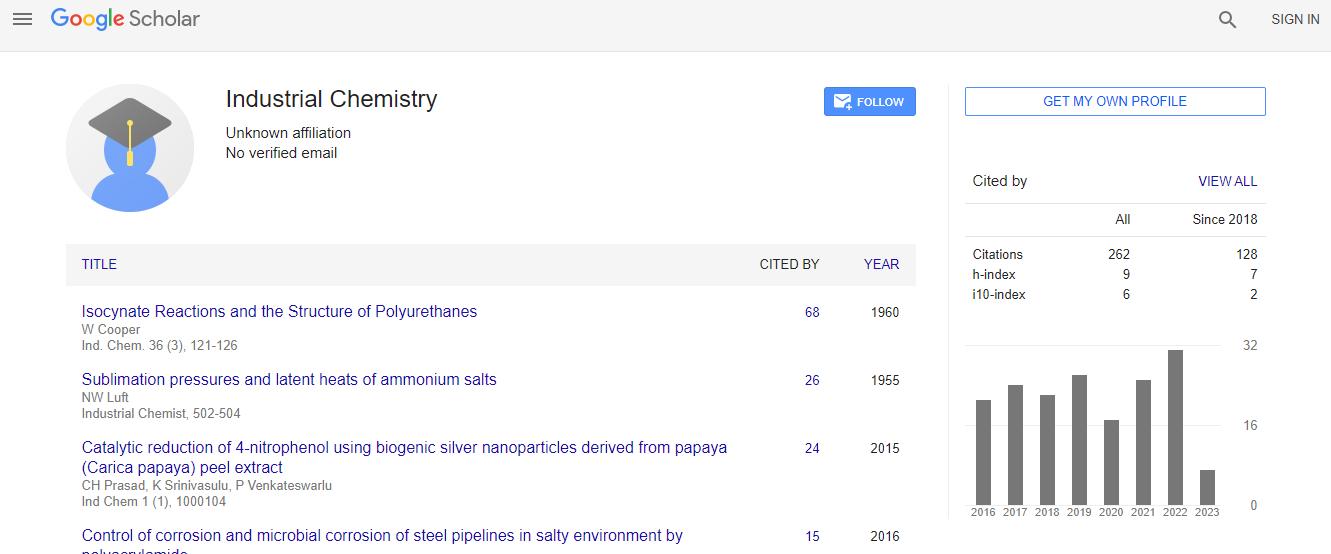Our Group organises 3000+ Global Conferenceseries Events every year across USA, Europe & Asia with support from 1000 more scientific Societies and Publishes 700+ Open Access Journals which contains over 50000 eminent personalities, reputed scientists as editorial board members.
Open Access Journals gaining more Readers and Citations
700 Journals and 15,000,000 Readers Each Journal is getting 25,000+ Readers
Google Scholar citation report
Citations : 262
Industrial Chemistry received 262 citations as per Google Scholar report
Indexed In
- Index Copernicus
- Google Scholar
- RefSeek
- Directory of Research Journal Indexing (DRJI)
- Hamdard University
- EBSCO A-Z
- OCLC- WorldCat
- Scholarsteer
- Geneva Foundation for Medical Education and Research
- Euro Pub
Useful Links
Recommended Journals
Related Subjects
Share This Page
Textile dye biosorption onto dried alkali treated sunflower seed hull: Isotherms, kinetics, thermodynamic studies and batch adsorber design
International Conference on Industrial Chemistry
Gbekeloluwa B Oguntimein
Morgan State University, USA
ScientificTracks Abstracts: Ind Chem
Abstract
Dyes containing effluents from textile and food industries cause serious environmental problems that can be mutagenic or carcinogenic and require pretreatment for color removal prior to disposal into aqueous systems. Treatment technologies like coagulation and flocculation reverse osmosis, photo degradation membrane separation; biodegradation, ion exchange, and adsorption are most often used for the treatment of dye containing wastewater. Among these methods, adsorption is simple and requires low maintenance and is the most widely used single method for the removal of dyes from aqueous solutions and effluent. This paper address the application of alkali treated dried sunflower seed hull (DSSH), a low cost material for the removal of textile dye from industrial wastewater effluent. Batch adsorption studies were performed as a function of contact time, initial solution pH, initial dye concentration and temperature. The optimum initial solution pH was found to be pH 2.2. Kinetic analysis revealed that adsorption experimental data was best fitted by pseudo-second order model at all textile dye concentration tested. Based on the rate constants obtained by this kinetic model using Arrhenius and Eyring equations, the activation parameters were determined, namely the activation energy (8.79 kJ/ mol), the change of entropy (-1.73 x 108 k J/ mol/ K), enthalpy (-6.20 kJ/ mol), and Gibbs free energy (range 5.06 x 1010√ʬ?¬?5.77 x 1010 kJ/ mol) for the formation of activated complex between Textile dye molecules and dried sunflower seed hull. The equilibrium adsorption data was found to follow the Langmuir isotherm model and maximum monolayer capacity was found to be 169.5 mg g_1 at 25oC. The Langmuir isotherm model was applied to the design of a single √ʬ?¬?stage absorber. Thermodynamics of dye adsorption revealed the process was spontaneous and exothermic in nature. The magnitude of enthalpy change (√?¬?H) was found to be 8.79 kJ/mol, indicating that physical forces were involved in adsorption of dye onto DSSH. This study revealed that DSSH a waste material may be a suitable adsorbent for decolorization of industrial effluents due to its low cost and high adsorption capacity.Biography
Gbekeloluwa B Oguntimein joined the MSU faculty in February 1997. He has more than 35 years experience in teaching, research, and administration in environmental engineering, biochemical engineering, chemical engineering, and food process engineering. He has served as Associate Professor, Acting Head of the Industrial Coordinating Unit, and Sub√ʬ?¬źDean of the Faculty of Technology at the University of Ibadan, Nigeria. He is now teaching, at the undergraduate and graduate levels, courses in environmental engineering, environmental impact and risk assessment, water supply engineering, biological wastewater treatment, civil engineering project management, and sustainable energy.
Email: bunmitundeo@gmail.com

 Spanish
Spanish  Chinese
Chinese  Russian
Russian  German
German  French
French  Japanese
Japanese  Portuguese
Portuguese  Hindi
Hindi 